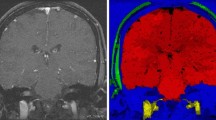Abstract
Image segmentation is the process of dividing an image into meaningful objects to perform different analysis operations. Fuzzy connectedness (FC)-based segmentation methods usually give robust segmentation results; on the other hand, they suffer from some weaknesses. The generalized or absolute fuzzy connectivity (GFC) segmentation method is the foundation of most FC-based methods. This method has two apparent weaknesses: It combines different objects in the case of their boundaries are blurred, and it can not find the object of interest if the threshold value determined without interactive manner. In this manuscript, we introduce extensions to the GFC algorithm to tackle the mentioned weaknesses. The FC and affinity functions in the extended algorithm utilize region- and boundary-based information to overcome the first weakness. Moreover, this algorithm suggests a near optimal threshold generated automatically to eliminate the need for any interaction. Comparisons has been made to quantitatively evaluate the proposed algorithm over a three sorts of data set of scenes. Measures of relevance have been calculated for two data sets. Results indicate improved segmentation accuracy and also showed that the weaknesses of the traditional GFC algorithms have been eliminated to some extent.
Similar content being viewed by others
References
Dougherty, G.: Digital Image Processing for Medical Applications. Cambridge University Press, Cambridge (2009)
Zaitoun, N.M.; Aqel, M.J.: Survey on image segmentation techniques. Proced. Comput. Sci. 65, 797–806 (2015)
Parida, P.; Bhoi, N.: Transition region based single and multiple object segmentation of gray scale images. Eng. Sci. Technol. Int. J. 19(3), 1206–1215 (2016)
Prabha, D.S.; Kumar, J.S.: Performance evaluation of image segmentation using objective methods. Indian J. Sci. Technol. 9(8) (2016). doi:10.17485/ijst/2016/v9i8/87907
Sonka, M.; Hlavac, V.; Boyle, R.: Image Processing, Analysis, and Machine Vision. Cengage Learning, Boston (2014)
Rueda, S.; Knight, C.L.; Papageorghiou, A.T.; Noble, J.A.: Feature-based fuzzy connectedness segmentation of ultrasound images with an object completion step. Med. Image Anal. 26(1), 30–46 (2015)
Saha, P.K.; Udupa, J.K.: Relative fuzzy connectedness among multiple objects: theory, algorithms, and applications in image segmentation. Comput. Vis. Image Underst. 82(1), 42–56 (2001)
Ciesielski, K.C.; Miranda, P.A.V.; Falcão, A.X.; Udupa, J.K.: Joint graph cut and relative fuzzy connectedness image segmentation algorithm. Med. Image Anal. 17(8), 1046–1057 (2013)
Udupa, J.K.; Saha, P.K.: Fuzzy connectedness and image segmentation. Proc. IEEE 91(10), 1649–1669 (2003)
Ciesielski, K.C.; Herman, G.T.; Kong, T.Y.: General theory of fuzzy connectedness segmentations. J. Math. Imaging Vis. 55(3), 304–342 (2016)
Imielinska, C.; Metaxas, D.; Udupa, J.; Jin, Yinpeng.; Chen, T.: Hybrid segmentation of the visible human data. In: Proceedings of the Third Visible Human Project Conference. Citeseer (2000)
Ciesielski, K.C.; Miranda, P.A.V.; Udupa, J.K.; Falcao, A.X.: Image segmentation by combining the strengths of relative fuzzy connectedness and graph cut. In: Proceedings of the 19th IEEE International Conference on Image Processing (ICIP), 2012, pp. 2005–2008. IEEE (2012)
Jones, T.N.; Metaxas, D.N.: Automated 3D segmentation using deformable models and fuzzy affinity. In: Proceedings of IPMI97. Lecture notes in computer science, vol 1230, Springer, Poultney, VT (1997)
Saha, P.K.; Udupa, J.K.; Odhner, D.: Scale-based fuzzy connected image segmentation: theory, algorithms, and validation. Comput. Vis. Image Underst. 77(2), 145–174 (2000)
Udupa, J.K.; Samarasekera, S.: Fuzzy connectedness and object definition: theory, algorithms, and applications in image segmentation. Graph. Models Image Process. 58(3), 246–261 (1996)
Mai, J.K.; Assheuer, J.; Paxinos, G.: Atlas of the Human Brain. Academic Press, San Diego (1997)
Mai, J.K.; Majtanik, M.; Paxinos, G.: Atlas of the Human Brain. Academic Press, San Diego (2015)
OBEID, M.; ALI, M.; MOHAMED, N.: Geochemical exploration on the stream sediments of Gabal El Mueilha area, central Eastern Desert, Egypt: An overview on the rare metals. Resour. Geol. 51(3), 217–227 (2001)
Saha, P.K.; Udupa, J.K.: Iterative relative fuzzy connectedness and object definition: theory, algorithms, and applications in image segmentation. In: IEEE Workshop on Mathematical Methods in Biomedical Image Analysis, 2000. Proceedings, pp. 28–35. IEEE (2000)
Author information
Authors and Affiliations
Corresponding author
Rights and permissions
About this article
Cite this article
Farag, T.H., Hassan, W.A., Ayad, H.A. et al. Extended Absolute Fuzzy Connectedness Segmentation Algorithm Utilizing Region and Boundary-Based Information. Arab J Sci Eng 42, 3573–3583 (2017). https://doi.org/10.1007/s13369-017-2577-0
Received:
Accepted:
Published:
Issue Date:
DOI: https://doi.org/10.1007/s13369-017-2577-0




